Analytical Investigation of Sound Radiation from Functionally Graded Thin Plates Based on Elemental Radiator Approach and Physical Neutral Surface
Abstract
:1. Introduction
2. Theoretical Modeling
2.1. Geometry and Material Properties
2.2. Significance of Physical Neutral Surface and Classical Plate Theory (CPT)
2.3. The FGM Plate’s Governing Differential Equation and Eigenvalues Computation Using CPT
2.4. Surface Velocity Computation in Normal Direction
2.5. Computation of Sound Radiation Fields
3. Results and Discussion
3.1. Comparative Study with the Available Published Results
3.2. Effects of the Power-Law Index on the Sound Radiation Fields of P-FGM Plate
3.3. Influence of Erat = Ec/Em Ratio on Sound Radiation Fields
3.4. Influence of Damping Loss Factor on the Sound Power Level of the P-FGM Constituents
3.5. Radiation Efficiencies Variation with Power-Law Indexes, Varied P-FGM Constituents, and Effects of Damping Loss Factor
4. Conclusions
- (a)
- The sound radiation fields validated with ANSYS and literature are in good agreement.
- (b)
- The sound power level monotonically increases with an increase in the power-law index because of a reduction in the stiffness of the FGM plate.
- (c)
- However, contrary to what other authors [29] have claimed, the acoustic response of P-FGM plates does not appear to always increase with an increase in the power-law index in the current study.
- (d)
- The current findings lead to conclude that there exists a key value of the power-law index for which the sound power level is at minimum in a specific frequency range.
- (e)
- Sound power level peak decreases and level shifts to higher frequencies with an increase in = = 2, 5, 10, 20, and 40.
- (f)
- It can also be said that the P-FGM plates’ material distribution (due to variation in power-law index ‘k’) plays the major role in the computation of the sound radiation of the FGM plate because it characterizes the stiffness variation of the structure.
Author Contributions
Funding
Conflicts of Interest
References
- Kumar, S.; Ranjan, V.; Jana, P. Free vibration analysis of thin functionally graded rectangular plates using the dynamic stiffness method. Compos. Struct. 2018, 197, 39–53. [Google Scholar] [CrossRef]
- Chi, S.-H.; Chung, Y.-L. Mechanical behavior of functionally graded material plates under transverse load—Part I: Analysis. Int. J. Solids Struct. 2006, 43, 3657–3674. [Google Scholar] [CrossRef] [Green Version]
- Chi, S.-H.; Chung, Y.-L. Mechanical behavior of functionally graded material plates under transverse load—Part II: Numerical results. Int. J. Solids Struct. 2006, 43, 3675–3691. [Google Scholar] [CrossRef] [Green Version]
- Wallace, C.E. Radiation Resistance of a Rectangular Panel. J. Acoust. Soc. Am. 1972, 51, 946–952. [Google Scholar] [CrossRef]
- Putra, A.; Thompson, D. Sound radiation from rectangular baffled and unbaffled plates. Appl. Acoust. 2010, 71, 1113–1125. [Google Scholar] [CrossRef]
- Putra, A.; Shyafina, N.; Thompson, D.; Muhammad, N.; Jailani, M.; Nor, M.; Nuawi, Z. Modelling Sound Radiation from a Baffled Vibrating Plate for different Boundary Conditions Using an Elementary Source Technique. InterNoise 2014, 249, 5812–5819. [Google Scholar]
- Geng, Q.; Li, H.; Li, Y. Dynamic and acoustic response of a clamped rectangular plate in thermal environments: Experiment and numerical simulation. J. Acoust. Soc. Am. 2014, 135, 2674–2682. [Google Scholar] [CrossRef] [Green Version]
- Geng, Q.; Li, Y. Solutions of dynamic and acoustic responses of a clamped rectangular plate in thermal environments. J. Vib. Control 2016, 22, 1593–1603. [Google Scholar] [CrossRef]
- Tao, J.; Ge, H.; Qiu, X. A new rule of vibration sampling for predicting acoustical radiation from rectangular plates. Appl. Acoust. 2006, 67, 756–770. [Google Scholar] [CrossRef]
- Kirkup, S. Computational solution of the acoustic field surrounding a baffled panel by the Rayleigh integral method. Appl. Math. Model. 1994, 18, 403–407. [Google Scholar] [CrossRef]
- Åbom, M.; Bodén, H. A method for estimating the sound power radiated from plates with prescribed excitation in the multi-mode region. Appl. Acoust. 1987, 22, 203–212. [Google Scholar] [CrossRef]
- Feit, D. Sound Radiation from Orthotropic Plates. J. Acoust. Soc. Am. 1970, 47, 388–389. [Google Scholar] [CrossRef]
- Reynders, E.; Van Hoorickx, C.; Dijckmans, A. Sound transmission through finite rib-stiffened and orthotropic plates. Acta Acust. United Acust. 2016, 102, 999–1010. [Google Scholar] [CrossRef]
- Zhou, K.; Su, J.; Hua, H. Closed Form Solutions for Vibration and Sound Radiation of Orthotropic Plates under Thermal Environment. Int. J. Struct. Stab. Dyn. 2018, 18, 1850098. [Google Scholar] [CrossRef]
- Kam, T.Y.; Lee, B.Y. Sound radiation of elastically restrained stiffened orthotropic plates. J. Acoust. Soc. Am. 2012, 131, 3232. [Google Scholar] [CrossRef]
- Cao, X.; Hua, H.; Zhang, Z. Sound radiation from shear deformable stiffened laminated plates. J. Sound Vib. 2011, 330, 4047–4063. [Google Scholar] [CrossRef]
- Cao, X.; Hua, H. Sound Radiation from Shear Deformable Stiffened Laminated Plates with Multiple Compliant Layers. ASME J. Vib. Acoust. 2012, 134, 51001. [Google Scholar] [CrossRef]
- Hao, W.F.; Wang, S.; Kam, T.Y. Sound Radiation of Laminated Composite Plates Partially Supported by Elastic Restraints. In Proceedings of the 13th AIAA/CEAS Aeroacoustics Conference (28th AIAA Aeroacoustics Conference), Rome, Italy, 21–23 May 2007; Volume 28, p. 3571. [Google Scholar]
- Li, X.; Yu, K.; Zhao, R. Vibro-acoustic response of a clamped rectangular sandwich panel in thermal environment. Appl. Acoust. 2018, 132, 82–96. [Google Scholar] [CrossRef]
- Arunkumar, M.P.; Jagadeesh, M.; Pitchaimani, J.; Gangadharan, K.V.; Babu, M.L. Sound radiation and transmission loss characteristics of a honeycomb sandwich panel with composite facings: Effect of inherent material damping. J. Sound Vib. 2018, 383, 221–232. [Google Scholar] [CrossRef]
- Sorrenti, M.; Di Sciuva, M.; Tessler, A. A robust four-node quadrilateral element for laminated composite and sandwich plates based on Refined Zigzag Theory. Comput. Struct. 2020, 242, 106369. [Google Scholar] [CrossRef]
- Chandra, N.; Gopal, K.V.N.; Raja, S. Vibro-acoustic response of sandwich plates with functionally graded core. Acta Mech. 2015, 228, 2775–2789. [Google Scholar] [CrossRef]
- Chandra, N.; Raja, S.; Gopal, K.V.N. A Comprehensive Analysis on the Structural–Acoustic Aspects of Various Functionally Graded Plates. Int. J. Appl. Mech. 2015, 7, 1550072. [Google Scholar] [CrossRef]
- Yang, T.; Huang, Q.; Li, S. Three-Dimensional Elasticity Solutions for Sound Radiation of Functionally Graded Materials Plates considering State Space Method. Shock Vib. 2016, 2016, 1403856. [Google Scholar] [CrossRef] [Green Version]
- Hasheminejad, S.M.; Shabanimotlagh, M. Sound Insulation Characteristics of Functionally Graded Panels. Acta Acust. United Acust. 2008, 94, 290–300. [Google Scholar] [CrossRef]
- Huang, C.; Nutt, S. An analytical study of sound transmission through unbounded panels of functionally gradedmaterials. J. Sound Vib. 2011, 330, 1153–1165. [Google Scholar] [CrossRef]
- Zhou, K.; Lin, Z.; Huang, X.; Hua, H. Vibration and sound radiation analysis of temperature-dependent porous functionally graded material plates with general boundary conditions. Appl. Acoust. 2019, 154, 236–250. [Google Scholar] [CrossRef]
- Yang, T.; Zheng, W.; Huang, Q.; Li, S. Sound radiation of functionally graded materials plates in thermal environment. Compos. Struct. 2016, 144, 165–176. [Google Scholar] [CrossRef]
- Chandra, N.; Raja, S.; Gopal, K.N. Vibro-acoustic response and sound transmission loss analysis of functionally graded plates. J. Sound Vib. 2014, 333, 5786–5802. [Google Scholar] [CrossRef]
- Belegundu, A.D.; Salagame, R.R.; Koopmann, G.H. A General Optimization Approach for Minimizing Acoustic Power Using Finite Elements; SAE Technical Paper 930198. In Proceedings of the International Congress & Exposition, Dearborn, MI, USA, 1 March 1993. [Google Scholar] [CrossRef]
- Chen, K.; Koopmann, G.H. Active Control of Low-Frequency Sound Radiation from Vibrating Panel Using Planar Sound Sources. ASME J. Vib. Acoust. 2002, 124, 2–9. [Google Scholar] [CrossRef]
- Arenas, J.; Crocker, M. Sound Radiation Efficiency of a Baffled Rectangular Plate Excited by Harmonic Point Forces Using its Surface Resistance Matrix. Int. J. Acoust. Vib. 2002, 7, 217–229. [Google Scholar] [CrossRef]
- Arenas, J.P. Numerical computation of the sound radiation from a planar baffled vibrating surface. J. Comput. Acoust. 2008, 16, 321–341. [Google Scholar] [CrossRef]
- Arenas, J.P. Matrix Method for Estimating the Sound Power Radiated from a Vibrating Plate for Noise Control Engineering Applications. Lat. Am. Appl. Res. 2009, 39, 345–352. [Google Scholar]
- Mao, Q.; Pietrzko, S. Control of Noise and Structural Vibration: A MATLAB®-Based Approach; Springer: London, UK, 2013; 377p. [Google Scholar]
- Nichols, R.H.; Lee, C.P.; Wang, T.G. Sound acoustics radiation from the vibration of functionally graded plates. J. Acoust. Soc. Am. 1988, 83, 62459–62461. [Google Scholar]
- Naghshineh, K.; Koopmann, G.H.; Belegundu, A.D. Material tailoring of structures to achieve a minimum radiation condition. J. Acoust. Soc. Am. 1992, 92, 841–855. [Google Scholar] [CrossRef]
- Putra, A.; Thompson, D. Sound radiation from perforated plates. J. Sound Vib. 2007, 329, 4227–4250. [Google Scholar] [CrossRef] [Green Version]
- Reddy, J.N.; Chin, C.D. Thermomechanical analysis of functionally graded cylinders and plates. J. Therm. Stress. 1998, 21, 593–626. [Google Scholar] [CrossRef]
- Reddy, J.N. Analysis of functionally graded plates. Int. J. Numer. Methods Eng. 2000, 684, 663–684. [Google Scholar] [CrossRef]
- Zhang, D.-G.; Zhou, Y.-H. A theoretical analysis of FGM thin plates based on physical neutral surface. Comput. Mater. Sci. 2008, 44, 716–720. [Google Scholar] [CrossRef]
- Yin, S.; Yu, T.; Liu, P. Free Vibration Analyses of FGM Thin Plates by Isogeometric Analysis Based on Classical Plate Theory and Physical Neutral Surface. Adv. Mech. Eng. 2013, 5, 634584. [Google Scholar] [CrossRef]
- Abrate, S. Functionally graded plates behave like homogeneous plates. Compos. Part B Eng. 2008, 39, 151–158. [Google Scholar] [CrossRef]
- Thai, C.H.; Kulasegaram, S.; Tran, L.V.; Nguyen-Xuan, H. Generalized shear deformation theory for functionally graded isotropic and sandwich plates based on isogeometric approach. Comput. Struct. 2014, 141, 94–112. [Google Scholar] [CrossRef]
- Mori, T.; Tanaka, K. Average stress in matrix and average elastic energy of materials with misfitting inclusions. Acta Met. 1973, 21, 571–574. [Google Scholar] [CrossRef]
- Jha, D.K.; Kant, T.; Singh, R.K. A critical review of recent research on functionally graded plates. Compos. Struct. 2013, 96, 833–849. [Google Scholar] [CrossRef]
- Abrate, S. Free vibration, buckling, and static deflections of functionally graded plates. Compos. Sci. Technol. 2006, 66, 2383–2394. [Google Scholar] [CrossRef]
- Cinefra, M.; Soave, M. Accurate vibration analysis of multi-layered plates made of functionally graded materials. Mech. Adv. Mater. Struct. 2011, 18, 3–13. [Google Scholar] [CrossRef]
- Thai, H.-T.; Vo, T.P. A new sinusoidal shear deformation theory for bending, buckling, and vibration of functionally graded plates. Appl. Math. Model. 2013, 37, 3269–3281. [Google Scholar] [CrossRef]
- Zhang, Y.B.; Bi, C.X.; Chen, X.Z.; Chen, J. Computation of acoustic radiation from vibrating structures in motion. Appl. Acoust. 2008, 69, 1154–1160. [Google Scholar] [CrossRef]
- Li, W.; Geng, Q.; Li, Y.M. Theoretical Analyses of Vibration and Sound Radiation Responses of Heated Symmetric Laminated Plates in Pre- and Post-Buckling Ranges. Appl. Mech. Mater. 2015, 775, 23–27. [Google Scholar] [CrossRef]
- Morimoto, T.; Tanigawa, Y.; Kawamura, R. Thermal buckling of functionally graded rectangular plates subjected to partial heating. Int. J. Mech. Sci. 2006, 48, 926–937. [Google Scholar] [CrossRef]
- Ruan, M.; Wang, Z.-M. Transverse vibrations of moving skew plates made of functionally graded material. J. Vib. Control 2016, 22, 3504–3517. [Google Scholar] [CrossRef]
- Singh, B.N.; Ranjan, V.; Hota, R.N. Vibroacoustic response from thin exponential functionally graded plates. Ing. Arch. 2022, 92, 2095–2118. [Google Scholar] [CrossRef]
- Singh, B.N.; Hota, R.N.; Dwivedi, S.; Jha, R.; Ranjan, V. Acoustic Response of Sigmoid Functionally Graded Thin Plates: A Parametric Investigation. J. Vib. Eng. Technol. 2022, 1–21. [Google Scholar] [CrossRef]
- Singh, B.N.; Ranjan, V.; Hota, R. Vibroacoustic response of mode localized thin functionally graded plates using physical neutral surface. Compos. Struct. 2022, 287, 115301. [Google Scholar] [CrossRef]
- Ali, M.I.; Azam, M.S.; Ranjan, V.; Bannerjee, J.R. Free vibration of sigmoid functionally graded plate using Dynamic Stiffness Method and Wittrick-Williams Algorithm. J. Comput. Struct. 2021, 244, 106424. [Google Scholar] [CrossRef]

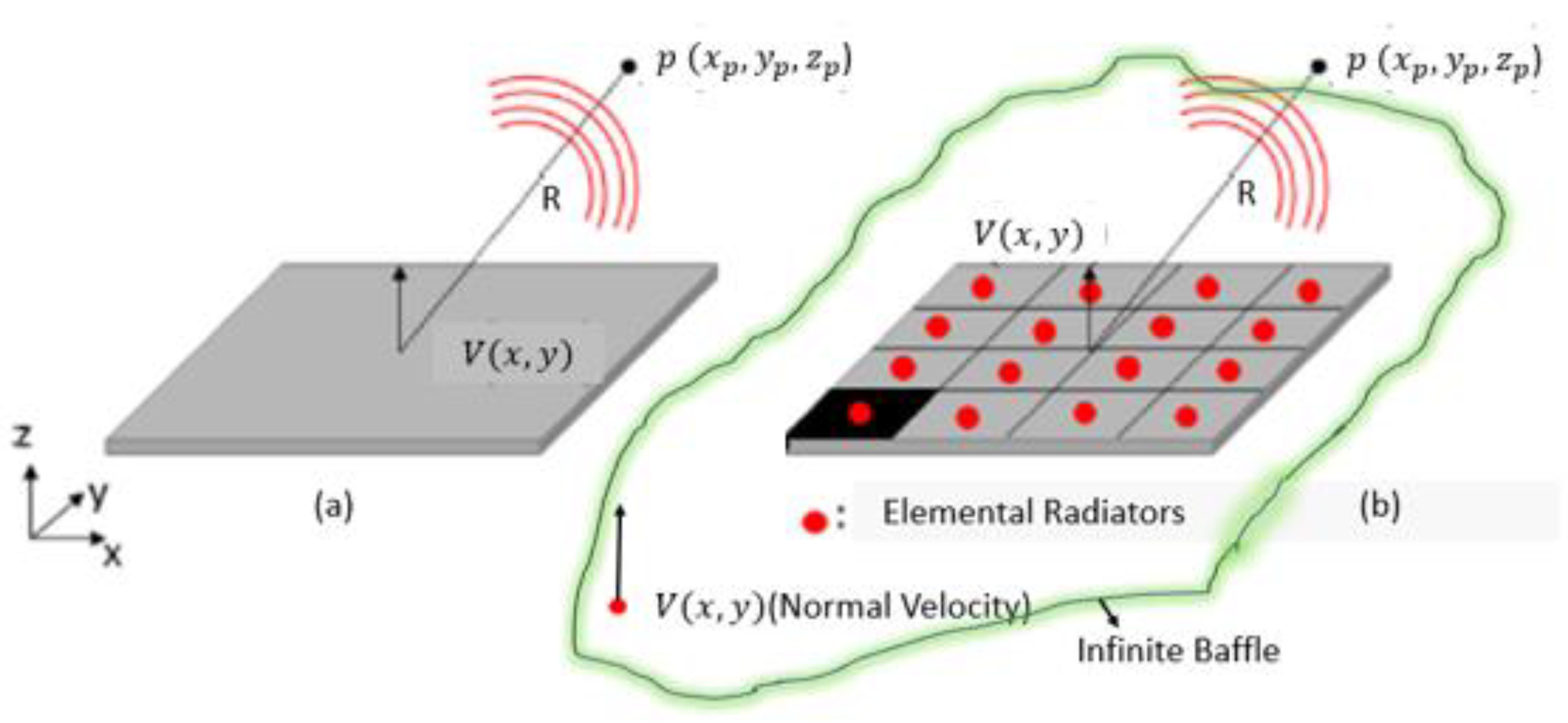
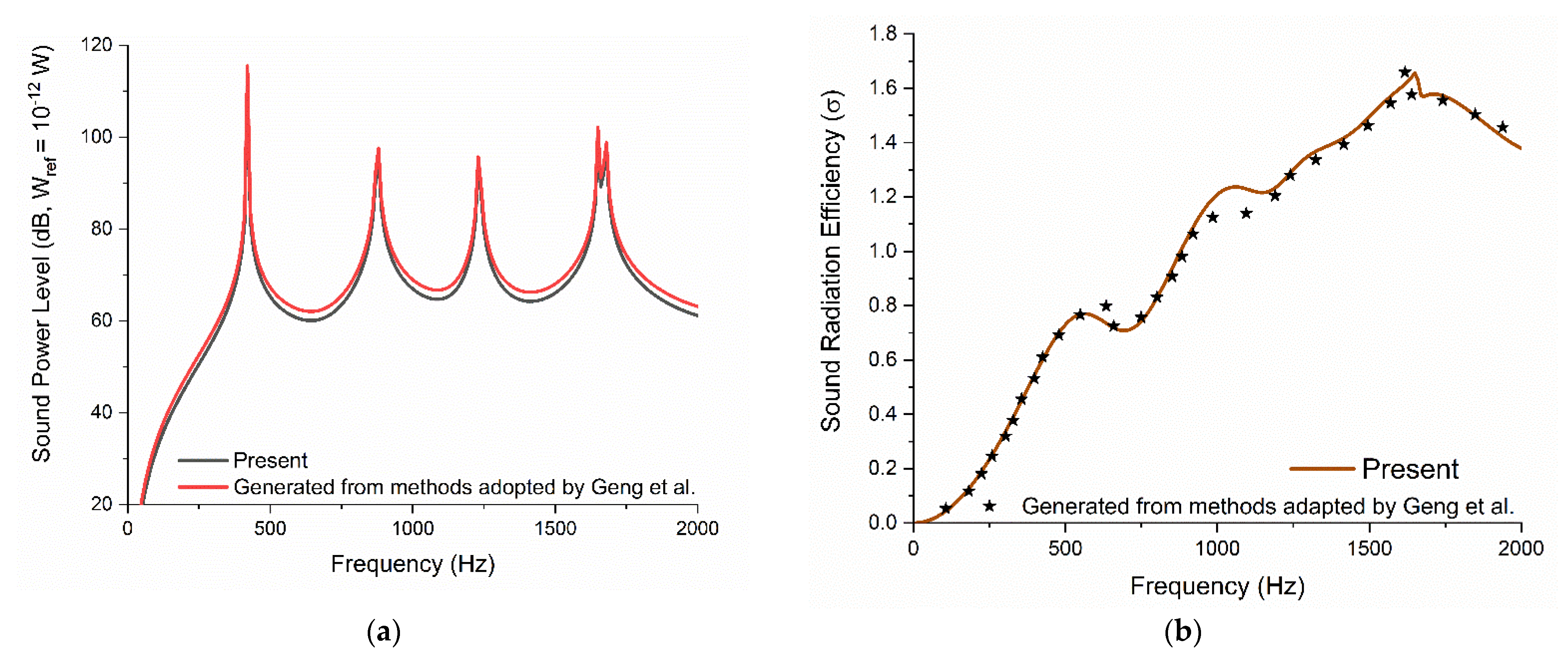
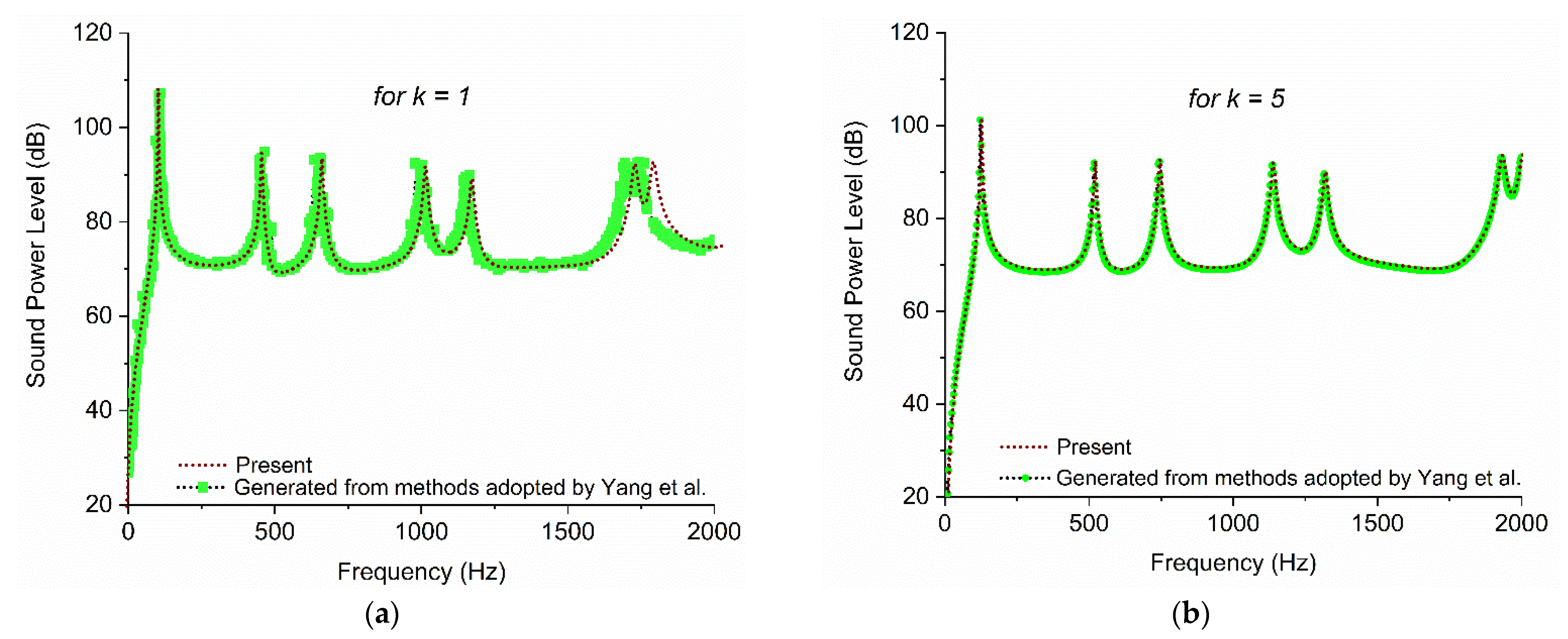
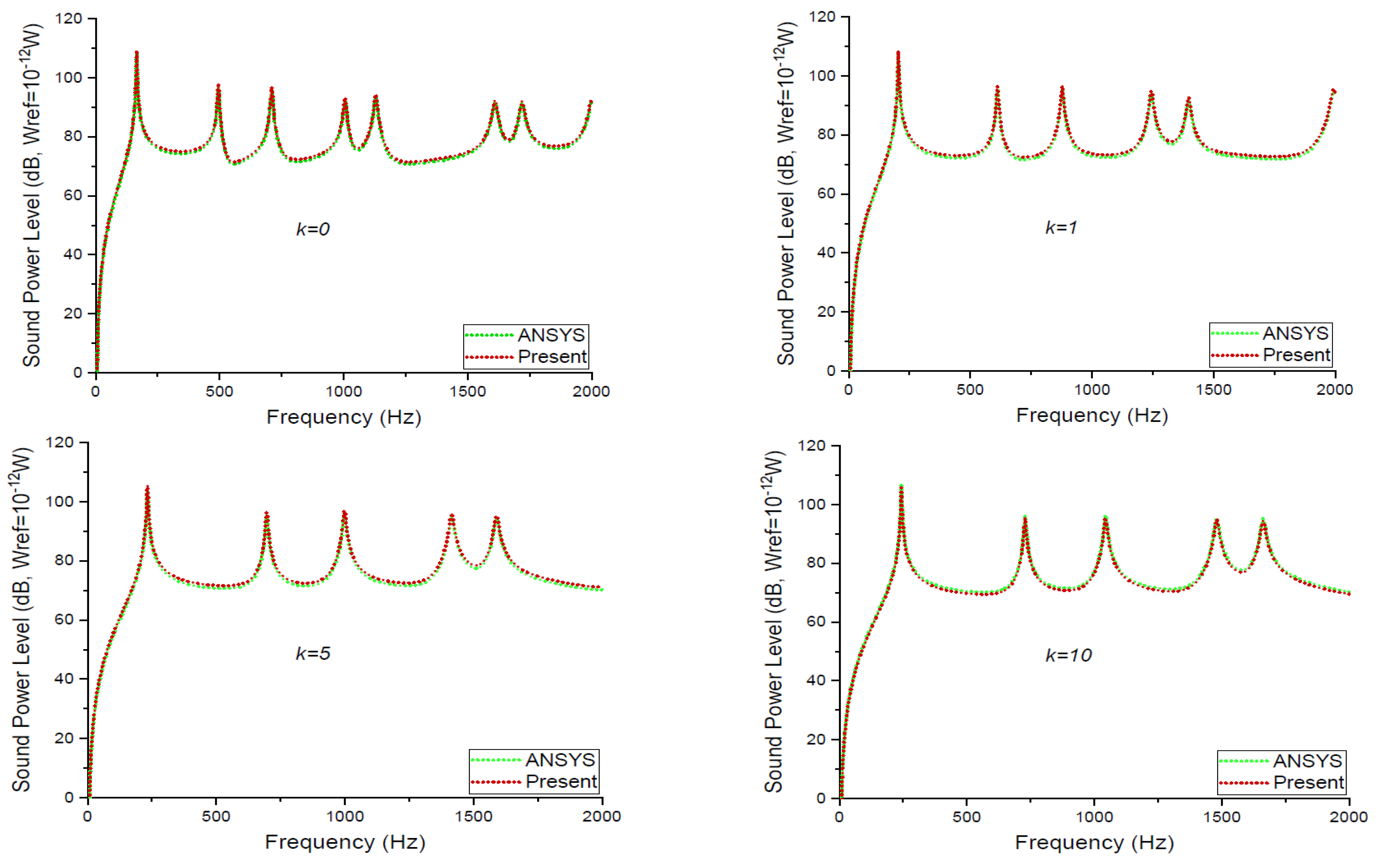
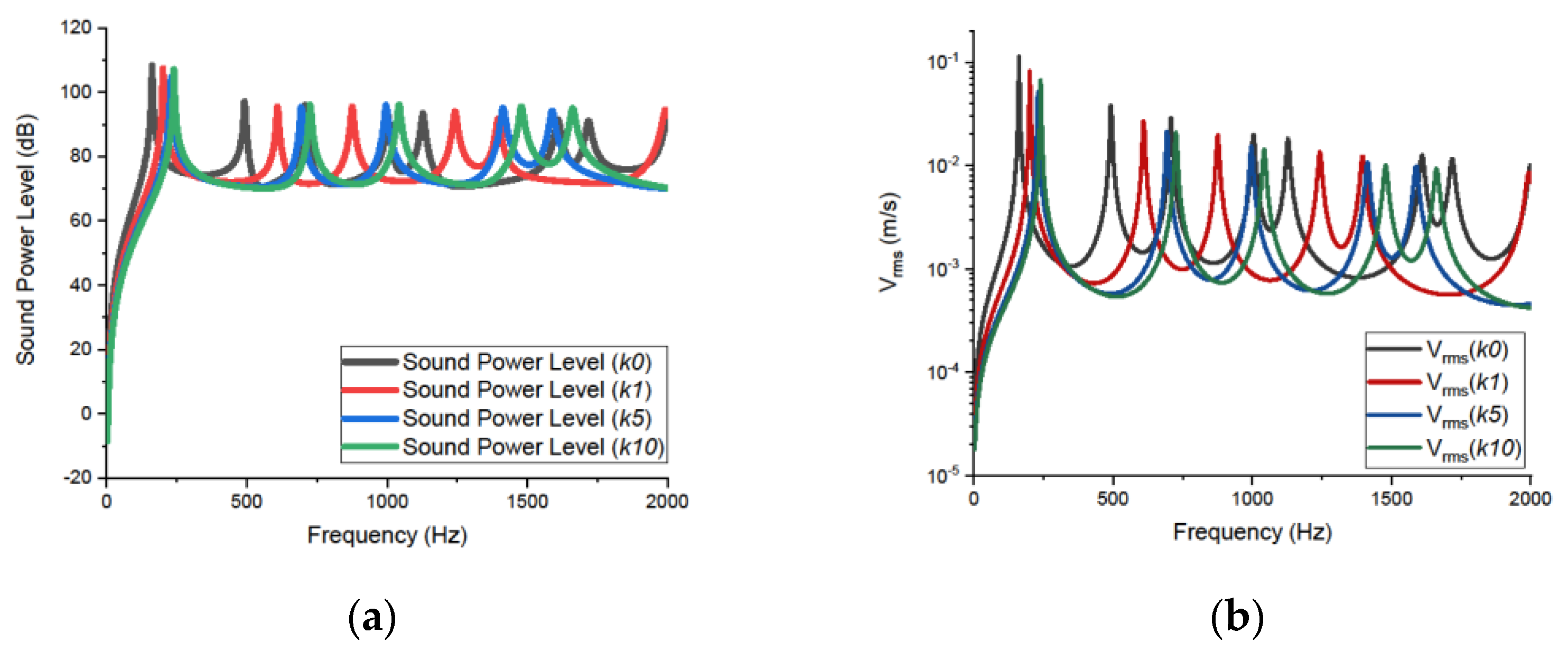
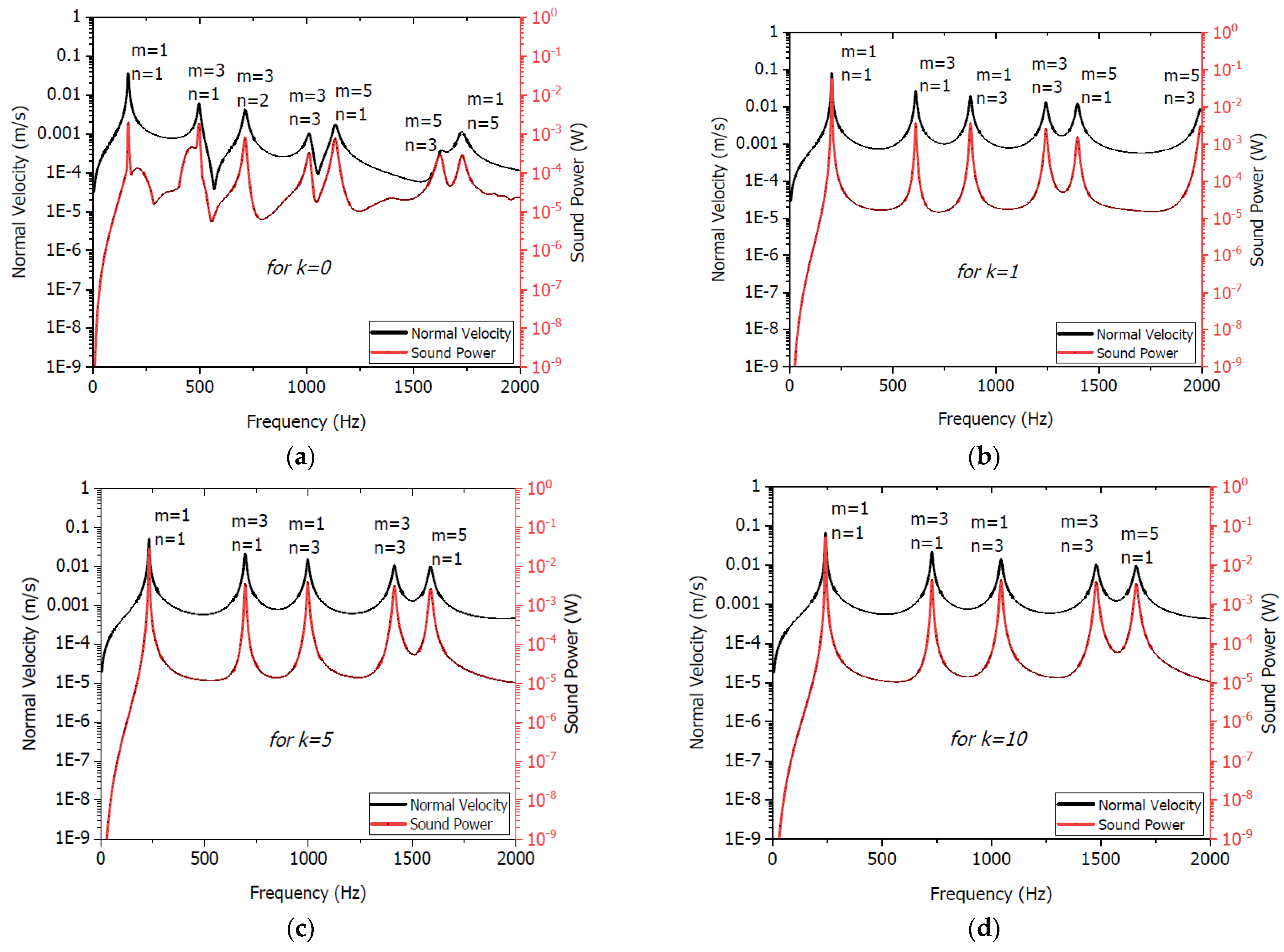
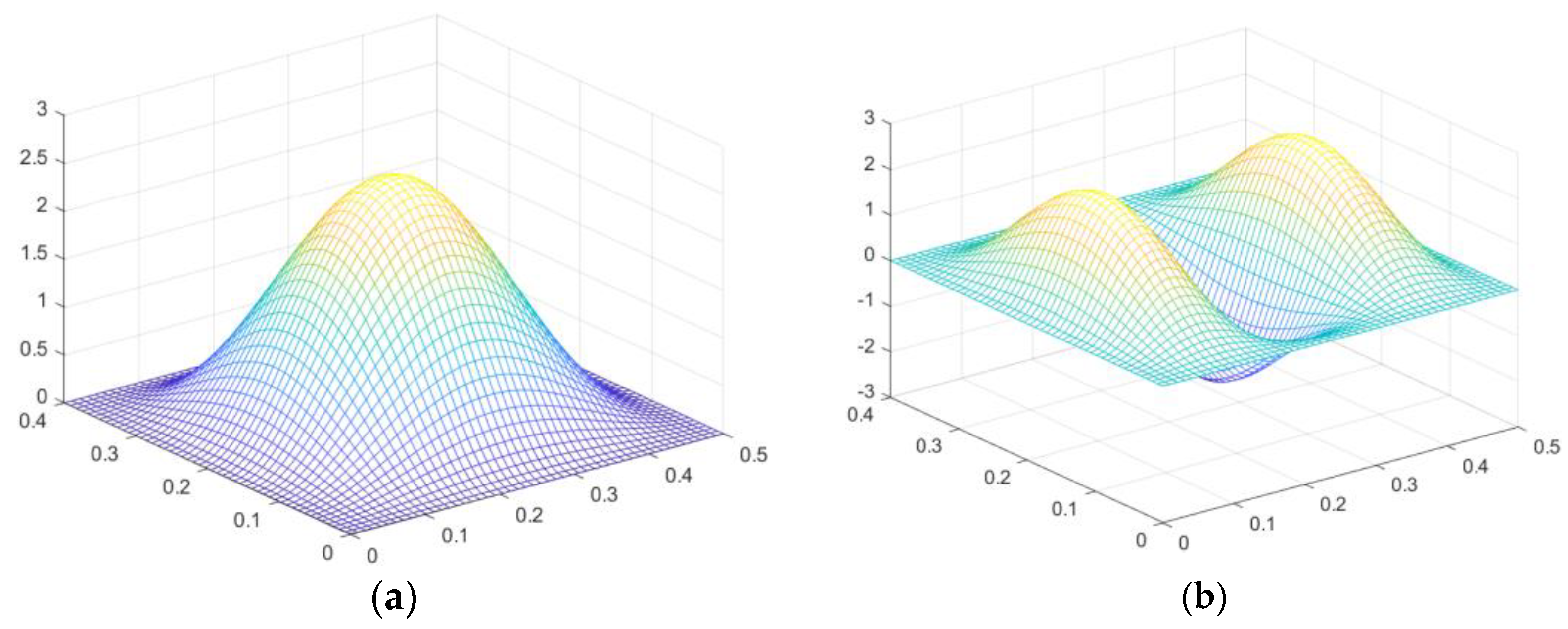
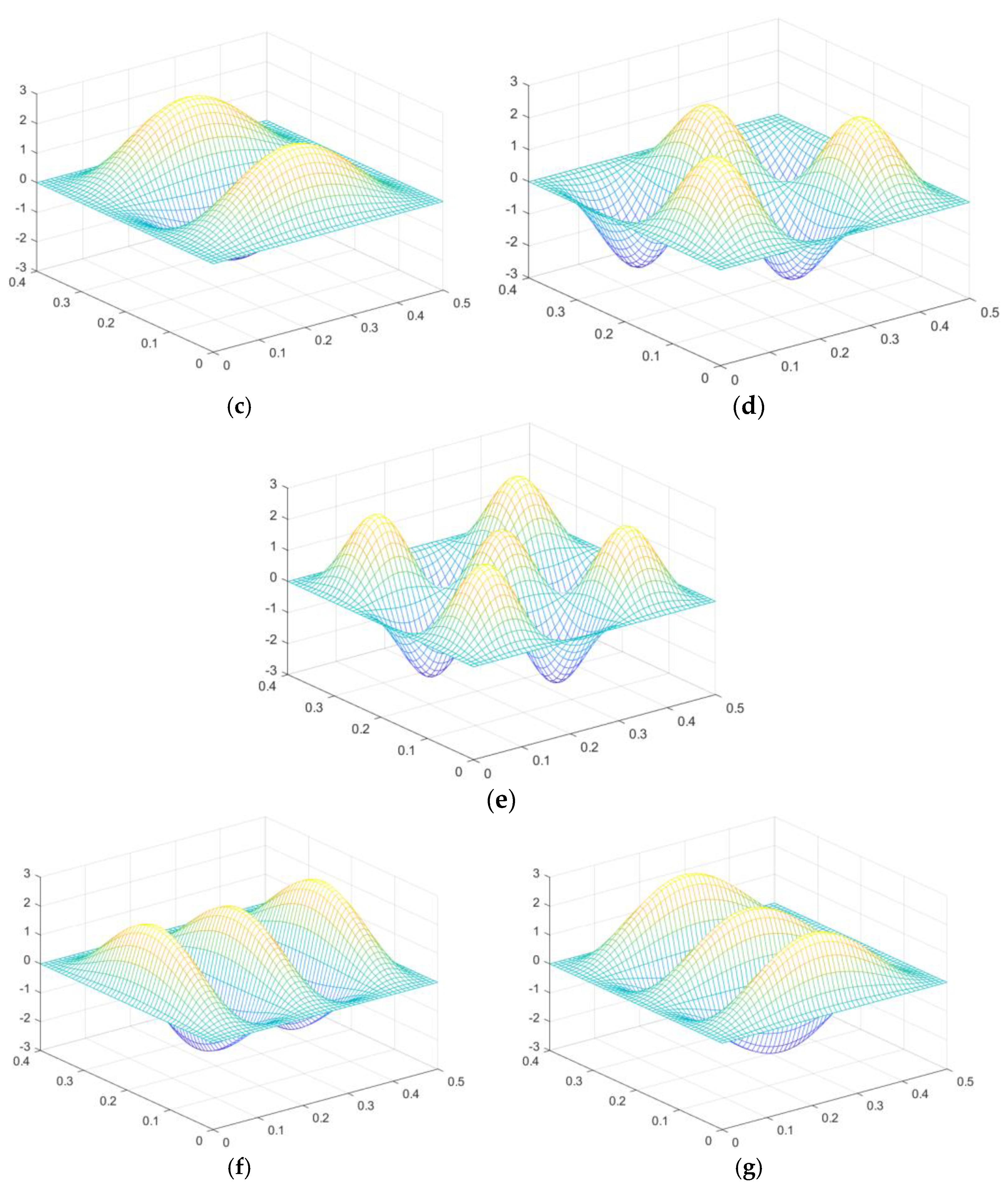
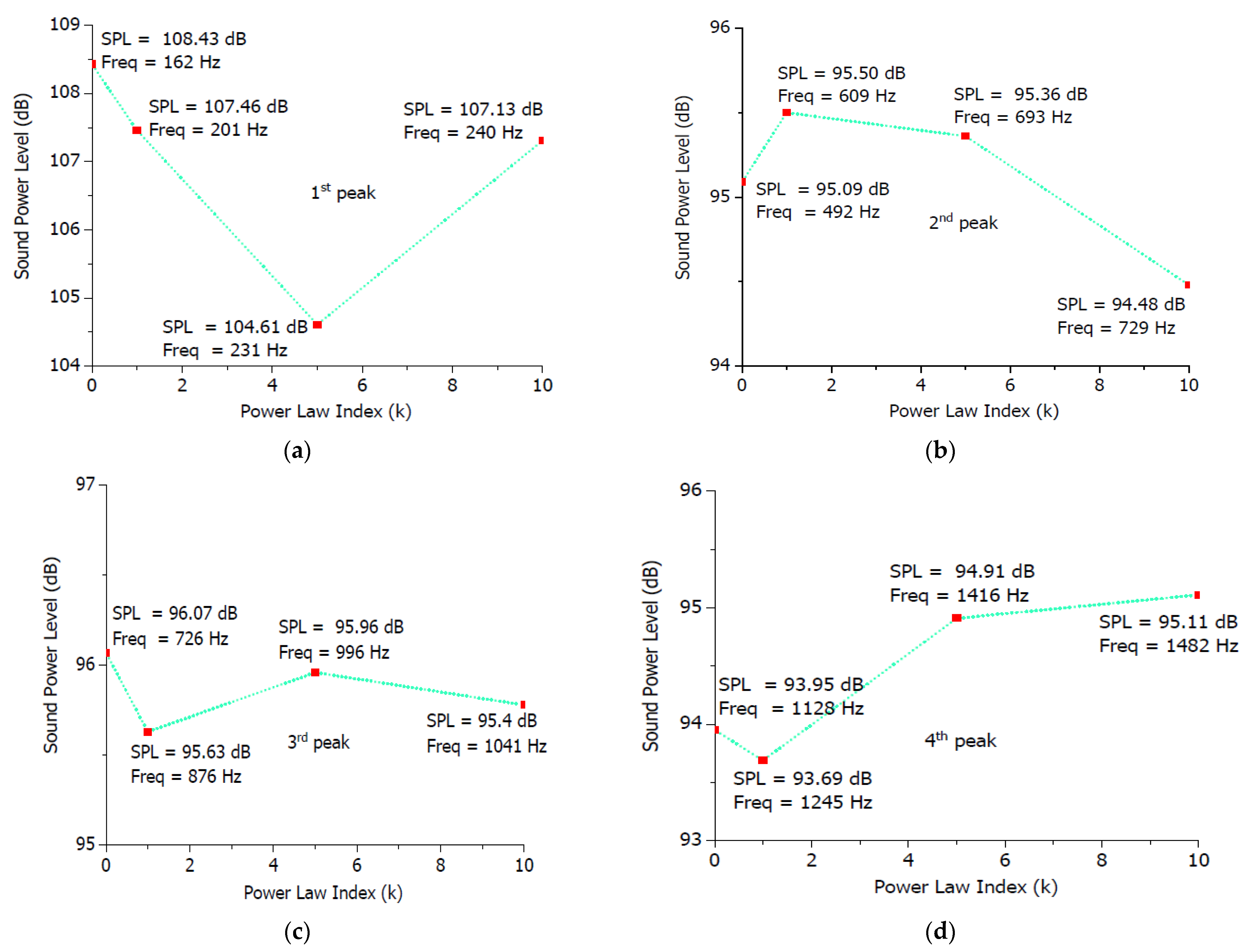
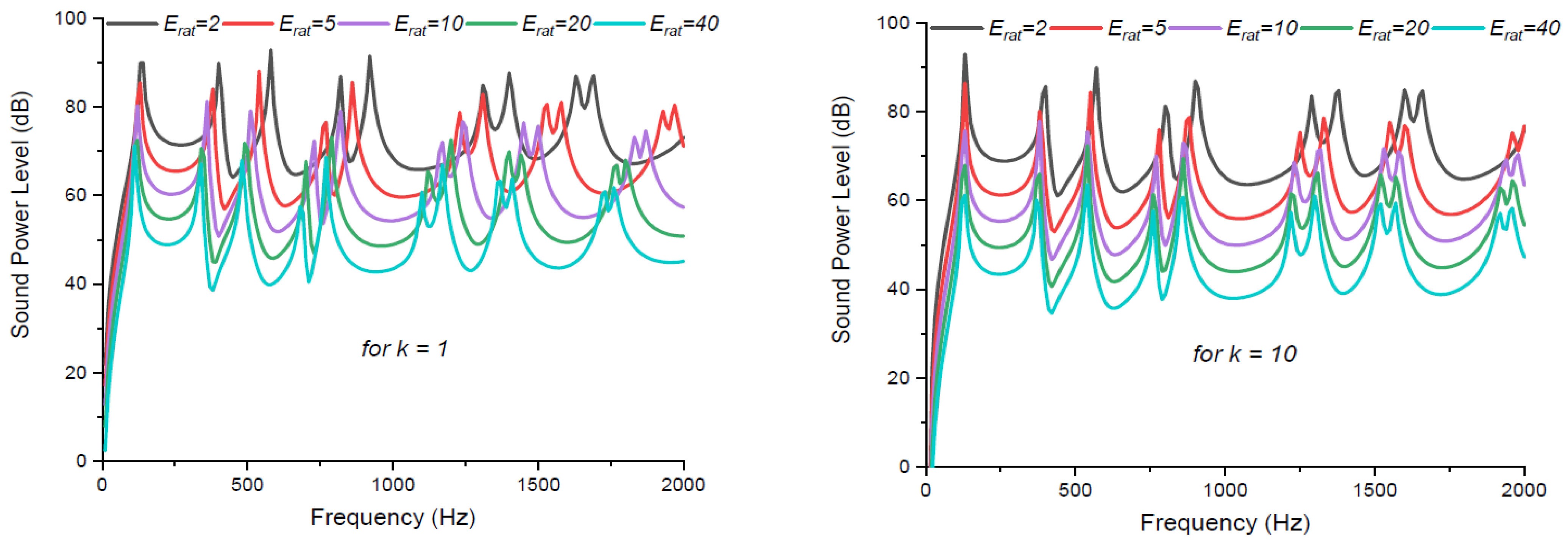
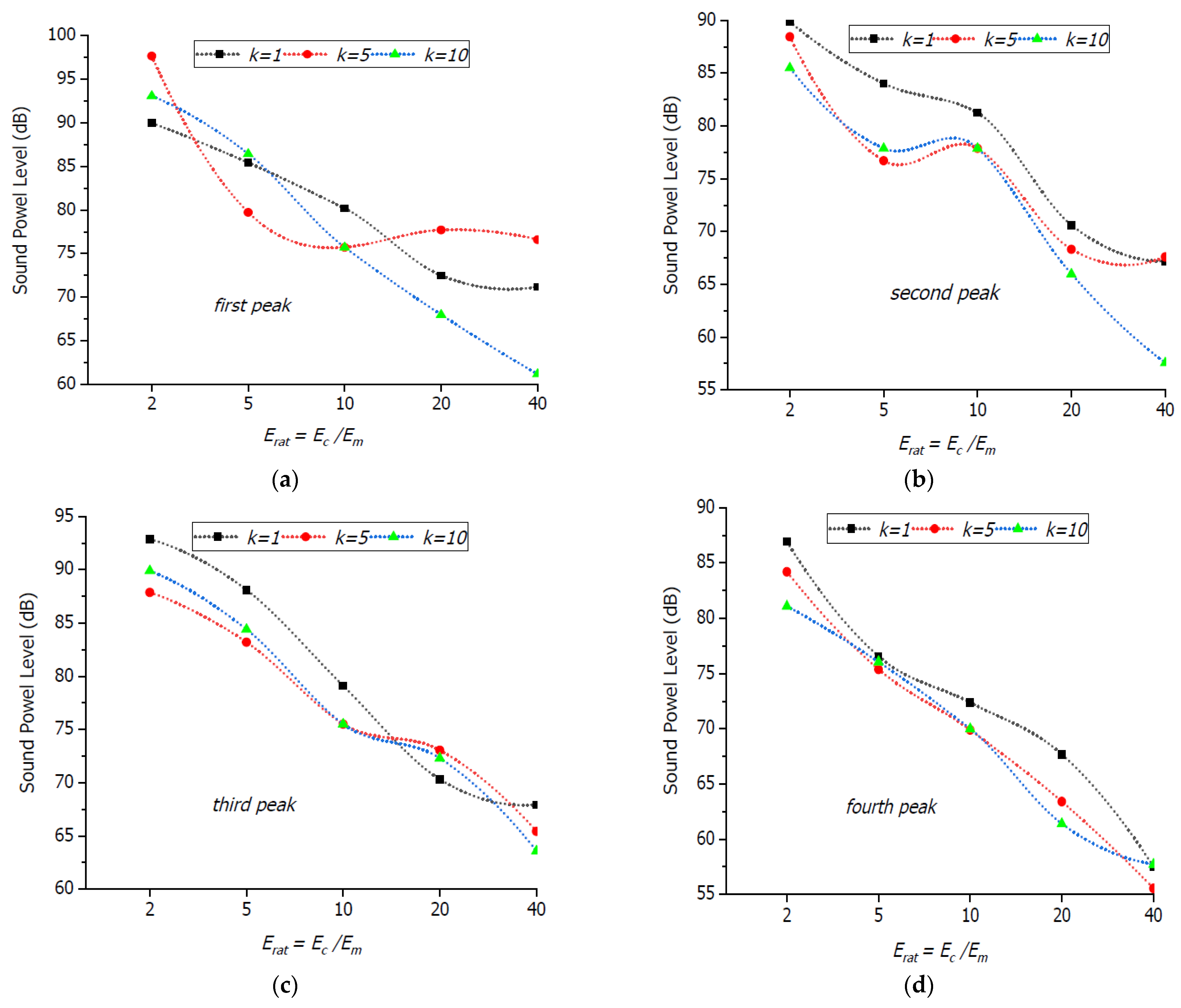
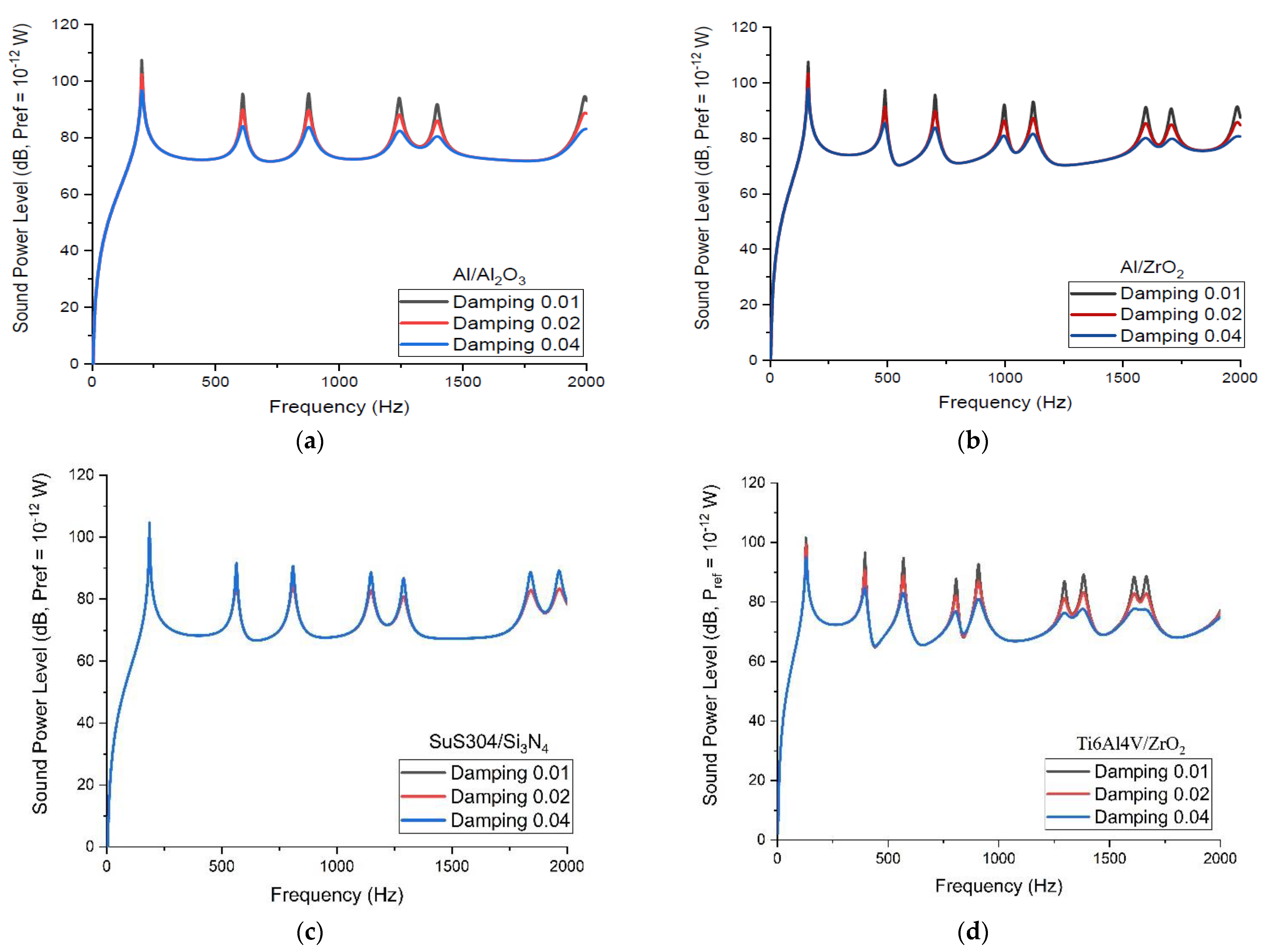
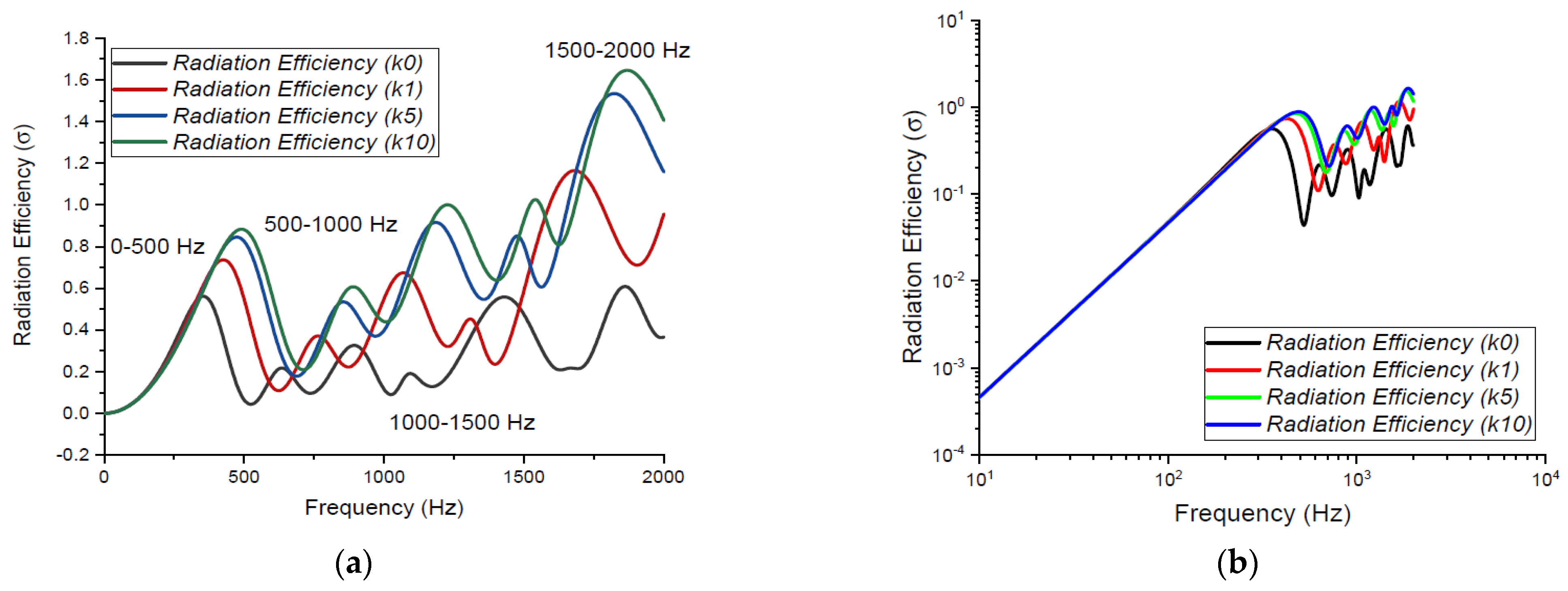
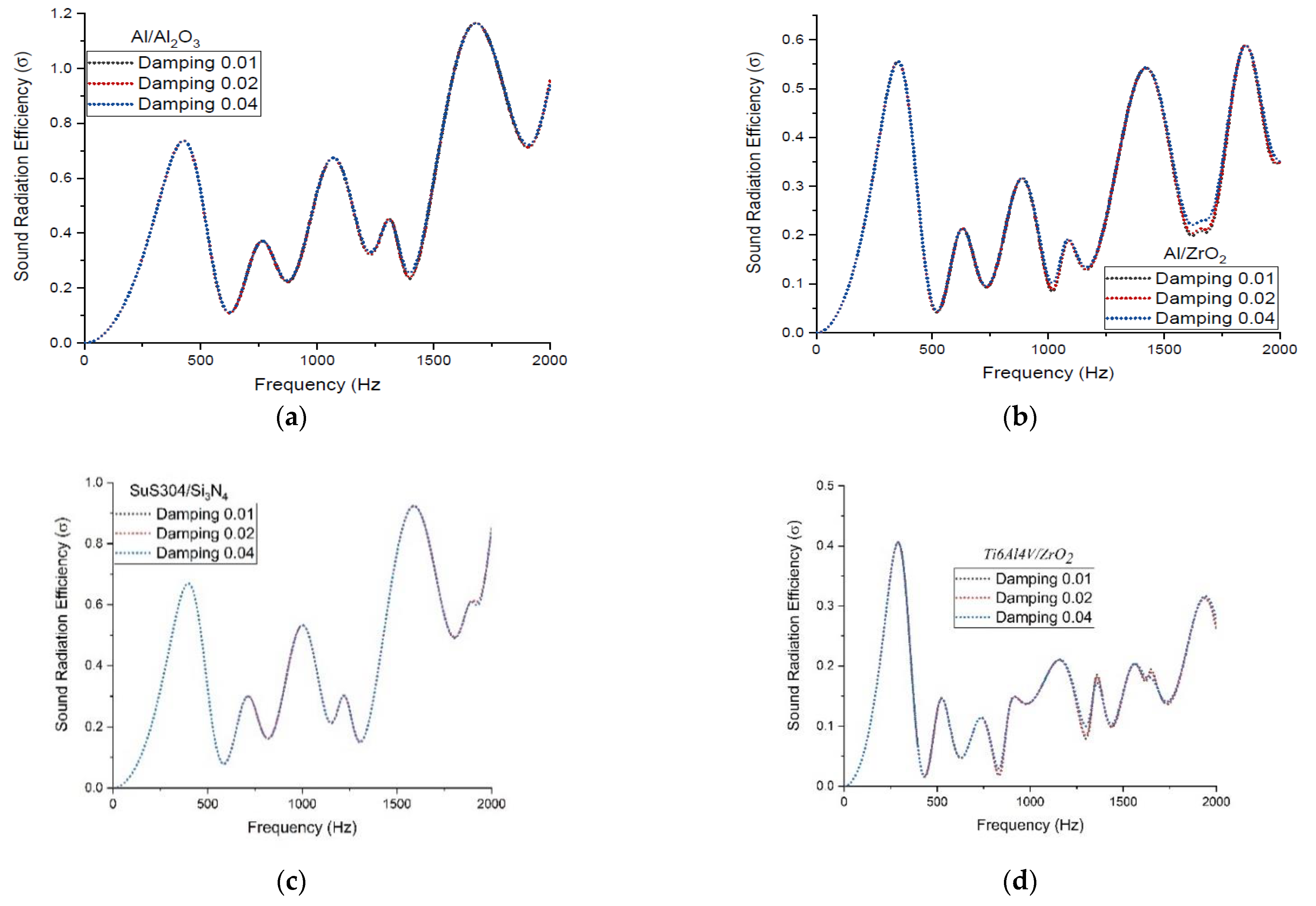
Publisher’s Note: MDPI stays neutral with regard to jurisdictional claims in published maps and institutional affiliations. |
© 2022 by the authors. Licensee MDPI, Basel, Switzerland. This article is an open access article distributed under the terms and conditions of the Creative Commons Attribution (CC BY) license (https://creativecommons.org/licenses/by/4.0/).
Share and Cite
Singh, B.N.; Hota, R.N.; Dwivedi, S.; Jha, R.; Ranjan, V.; Řehák, K. Analytical Investigation of Sound Radiation from Functionally Graded Thin Plates Based on Elemental Radiator Approach and Physical Neutral Surface. Appl. Sci. 2022, 12, 7707. https://doi.org/10.3390/app12157707
Singh BN, Hota RN, Dwivedi S, Jha R, Ranjan V, Řehák K. Analytical Investigation of Sound Radiation from Functionally Graded Thin Plates Based on Elemental Radiator Approach and Physical Neutral Surface. Applied Sciences. 2022; 12(15):7707. https://doi.org/10.3390/app12157707
Chicago/Turabian StyleSingh, Baij Nath, R. N. Hota, Sarvagya Dwivedi, Ratneshwar Jha, Vinayak Ranjan, and Kamil Řehák. 2022. "Analytical Investigation of Sound Radiation from Functionally Graded Thin Plates Based on Elemental Radiator Approach and Physical Neutral Surface" Applied Sciences 12, no. 15: 7707. https://doi.org/10.3390/app12157707
APA StyleSingh, B. N., Hota, R. N., Dwivedi, S., Jha, R., Ranjan, V., & Řehák, K. (2022). Analytical Investigation of Sound Radiation from Functionally Graded Thin Plates Based on Elemental Radiator Approach and Physical Neutral Surface. Applied Sciences, 12(15), 7707. https://doi.org/10.3390/app12157707






